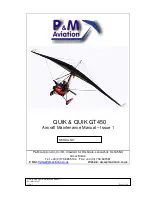
P a g e
|
26
3.
Trial fit the two stab parts together.
NOTE:
It is vital that the two stabilizers are at 90°
to each other in both the vertical and horizontal dimensions!
4.
Alignment horizontally (fore/aft) is achieved by carefully aligning the bottom edge of the
horizontal stab with the bottom edge of the cut for the boom in the vertical stab.
5.
Dry fit the parts together and check to see that they are square in both the horizontal and
vertical dimensions…then check it again!
6.
Remove the parts from the jig and glue them together. Again, many modelers use epoxy
here to take advantage of the increased setting time.
7.
Place everything back in the jig and check for square. Use weights, tape, pins,
string…whatever it takes…to ensure that they are aligned as perfectly as possible.
To attach the stabilizers to the boom:
Trial fit the assembly to the boom, and mark the contact points between the boom and the stab
assembly with a felt tip marker.
NOTE:
Ensure that
the vertical stab tracks a straight line down the center
of the boom!
1.
Use 150-220 grit sand paper to roughen the
surface of the CF boom where the stab
assembly will contact it.
2.
Use epoxy to attach the stab assembly to the
boom.
Attaching the Fuselage and Boom
The most critical part of this operation is to ensure that the flat across the wing saddle is perfectly
parallel to the horizontal stabilizer. How you ensure that the fuse and horizontal stab are parallel
is up to you. Methods range from using a digital inclinometer, a level, or even the Mk. I
Calibrated Eyeball.
To attach the fuselage to the boom assembly:
1.
If not done, cover the fuselage.
2.
Trial fit the fuse and boom assembly.
3.
Set the fuselage and horizontal stab parallel to
each other, then trace the rear outline of the
fuse where the boom emerges being careful
not to move anything.
4.
Separate the fuselage and boom, then roughen
the boom following the outline you just
traced back to where the boom emerges from
the tail block.
5.
Glue the fuselage to the boom using the tracing to ensure that the fuse and the horizontal
stab are parallel. Epoxy is recommended for this operation.
6.
Allow to cure undisturbed, and you’ll have a completed pod-boom-tail component!
HINT
ONE OF THE MOST USEFUL TOOLS
THAT YOU CAN HAVE ON YOUR BENCE
IS A COMMON EMERY BOARD. THEY
MAKE GREAT SANDING STICKS.
HINT
SEVERAL FREE OR INEXPENSIVE SMART
PHONE INCLINOMETER APPS ARE
AVAILABLE. ONE OF THE MOST
RECOMMENDED IS
‘CLINOMETER’
,
AVAILABLE FOR BOTH ANDROID AND
MAC.








































